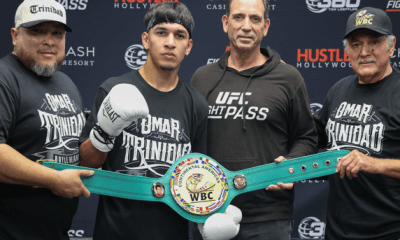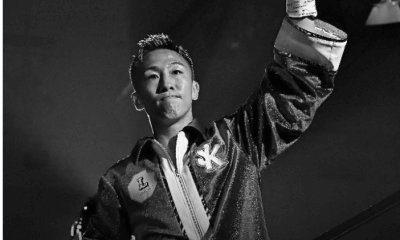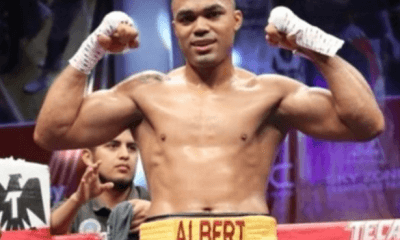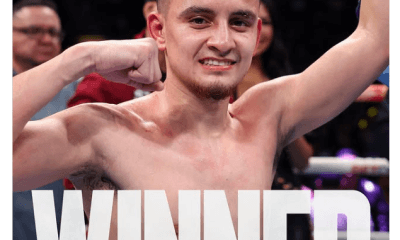Featured Articles
Kazuto Ioka Sensationally Crushes Kosei Tanaka in Japanese Superfight
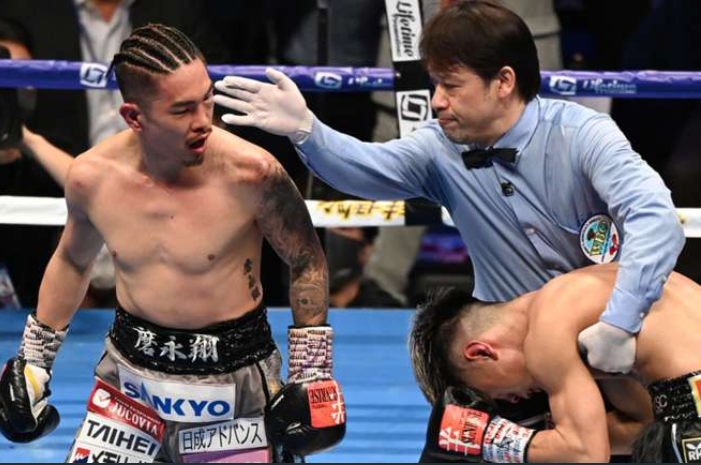
In what proved to be a very happy new year for fight fans, Kazuto Ioka scored a sensational eighth round knockout of wonderkid Kosei Tanaka in what stands as a wonderful advertisement for seasoning, for experience, for cooler heads.
The Japanese superfight saw Tanaka, ranked the number one flyweight contender in the world, stepping up to attack the 115lb division in the shape of Ioka, ranked number four in what remains one of the most stacked divisions in the sport.
The younger, more explosive, quicker Tanaka was the favourite and the first round revealed why. Tanaka’s superb, gliding footwork kept him in range, where he most wants to be, betting on himself to win exchanges against an older, slower fighter. Ioka found himself blasted with a straight right-hand in the very first seconds, dis-heartening in that this was the punch he himself was supposed to utilise to keep Tanaka honest. Pushed around the ring with jabs, he also found himself the target of a florid offence, Tanaka treating him with real contempt, throwing expansive combinations with the expectation of landing them. Ioka absorbed this information and landed some jabs of his own to close out the round, a warning that went unheeded by young Tanaka.
So he was punished; Ioka took advantage of punches that were over-extended tactically if not technically to win the second round. The two swapped jabs early, Tanaka’s apparently the more hurtful, but with thirty-five seconds remaining in the round, Ioka sounded his first warning shot, a booming right hand that evened the contest on the cards and gave the younger man something to think about.
Adaptions in boxing warm my heart. They speak of intelligence in the ring, of cornermen who know their job and are paying attention, of fighters of exponential potential. Tanaka showed a thrilling adaption in the third, tightening up and going to the body as Ioka unexpectedly gave ground. It was a misstep from the more experienced man who allowed Tanaka to generate painful momentum. Ioka, however, has been there and done it. He offered his own adaption in the fourth, moving Tanaka about the ring with his own punches, standing his ground and forcing Tanaka to visit him in the pocket. The result was success with punches that felt, perhaps, that they should not have been landing. Hooks, especially, seemed to trouble Tanaka, still betting on himself to win hurtful exchanges but now running neck and neck.
It was a close round then, but Ioka edged it for me and in edging it he took a split of the first third of the fight and made clear that he would not be bulldozed by Tanaka, and therefore by nobody. The absolute clarity with which he approached the fifth underlined this. Having measured Tanaka’s much vaunted guns and found them wanting, Ioka fought the round with, if not quite contempt, then with no fear. Well-positioned and making small moves to take away Tanaka’s circling footwork, Ioka engaged with Tanaka as per his wishes and they exchanged hard punches through the first two minutes. His left eye closing but bright, Ioka endured the flurry Tanaka landed on forty-five seconds and then dropped him neatly with a counter left that left his opponent on his haunches, hurt and suddenly uncertain, in the apex of a disaster that had unexpectedly visited him.
Ioka looked absolute in charge in the sixth, economical, careful, unhurried. Here is the value of experience, the warning to all the wonderkids that stalk boxing, the terrifying visage of the man who knows more than you and uses it to hurt you. Tuning in now you would not know that Ioka had dropped Tanaka in the fifth but rather would assume that the master was dishing out a lesson in boxing control to the younger man, who might be expected to come on late. Using Tanaka’s enthusiasm, desperation, against him, he scored consistently and with technical surety, brushing past Tanaka’s second minute success and allowing him to rush himself onto what now seems an inevitable second knockdown.
But it was not inevitable.
Instead, it was bought by careful deconstruction of Tanaka’s style in a manner that absolved Ioka for his pre- (and post-!) fight claims to inherent superiority over his foe. The second knockdown, a near replay of the first, seemed to seal the fight. Tanaka, hurting, was in need now of a knockout to win, and Ioka looked more poised and more controlled than at any time in the fight.
Remember those punches Ioka was landing in the fourth that I said seemed as though they shouldn’t be? Ioka never stopped landing such punches from that moment on, and in the fifth and sixth those same punches took the fight. In the seventh, Ioka began to open up, felt something he didn’t like, returned to careful boxing. What he didn’t like was the bodyshots and momentum both of which were generated, or rather allowed, by Ioka’s aggression. This was the final adaption and one that Tanaka would never be capable of. Ioka recognises an over-step in his own offence and so reigns it in. As a result, he won a close, arguable round and goes again in the eighth.
And it was in the eighth that what he had worked for all this year came to fruition. The right hand, the punch he was expected to use from go, was finally uncorked in earnest and the result was a referee holding up a sagging Tanaka while waving the contest off. It happened so fast it seemed momentarily unreal, perhaps even premature, but Tanaka did not protest the stoppage and in fact nodded to the referee, patted him on the back. Replays revealed a fighter momentarily boneless. Dazed but unbowed, Tanaka recovered enough to congratulate his masterful opponent and the two hugged it out in the corner.
Ioka said what he was going to do, did it, then spent some time on the microphone pointing out that he had done it; what he does next is up to him, he can write his own 115lb story, his 2018 split loss to Donnie Nietes a distant memory. The winner of the mouth-watering rematch between Roman Gonzalez and champion Juan Francisco Estrada would seem most natural, but there is Thai tough Srisaket Sor Rungvisai to consider, beltholder Jerwin Ancajas, a host of other lesser lights that would make for fascinating contests.
But perhaps most interesting of all for the ageing Ioka is fellow Japanese Naoya Inoue. Tanaka-Ioka was perhaps the first all-Japanese superfight to be thoroughly embraced by the western boxing fan, appealing beyond the hardcore fans I normally see amped up for the traditional New Year contest. Ioka-Naoya is next level and there are stylistic reasons to think Ioka may cause Naoya serious problems. It is a high-risk fight against a bigger man though, and while he has stylistic chances, they call for him to take serious stylistic risks – to allow The Monster to bloom and then try to punish him. Naoya is not Tanaka. The fight could be a thrill-ride, a clinic, or a decimation but what can be said with certainty is that it would be the biggest Japanese fight in history.
It is a nice problem for Ioka to have. Yesterday he was the betting underdog. Today, he is the second -most exalted fighter of Japan, as fight-wild a nation as rest upon the earth.
For Tanaka, a rebuild is required, but a minor one. He remains the number one flyweight on that same earth, and a match with veteran Moruti Mthalane is one of several contests available to him at 112lbs that fascinate. Both men are in for a must-watch 2021.
Photo credit: Getty Images via DAZN
Check out more boxing news on video at the Boxing Channel
To comment on this story in the Fight Forum CLICK HERE
-

 Featured Articles3 weeks ago
Featured Articles3 weeks agoThe Hauser Report: Zayas-Garcia, Pacquiao, Usyk, and the NYSAC
-

 Featured Articles2 weeks ago
Featured Articles2 weeks agoOscar Duarte and Regis Prograis Prevail on an Action-Packed Fight Card in Chicago
-

 Featured Articles1 week ago
Featured Articles1 week agoThe Hauser Report: Cinematic and Literary Notes
-

 Book Review4 days ago
Book Review4 days agoMark Kriegel’s New Book About Mike Tyson is a Must-Read
-

 Featured Articles4 weeks ago
Featured Articles4 weeks agoManny Pacquiao and Mario Barrios Fight to a Draw; Fundora stops Tim Tszyu
-

 Featured Articles4 weeks ago
Featured Articles4 weeks agoArne’s Almanac: Pacquiao-Barrios Redux
-

 Featured Articles3 weeks ago
Featured Articles3 weeks agoRemembering Dwight Muhammad Qawi (1953-2025) and his Triumphant Return to Prison
-
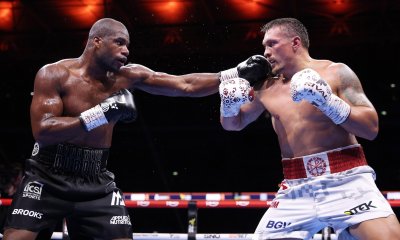
 Featured Articles4 weeks ago
Featured Articles4 weeks agoOleksandr Usyk Continues to Amaze; KOs Daniel Dubois in 5 One-Sided Rounds


